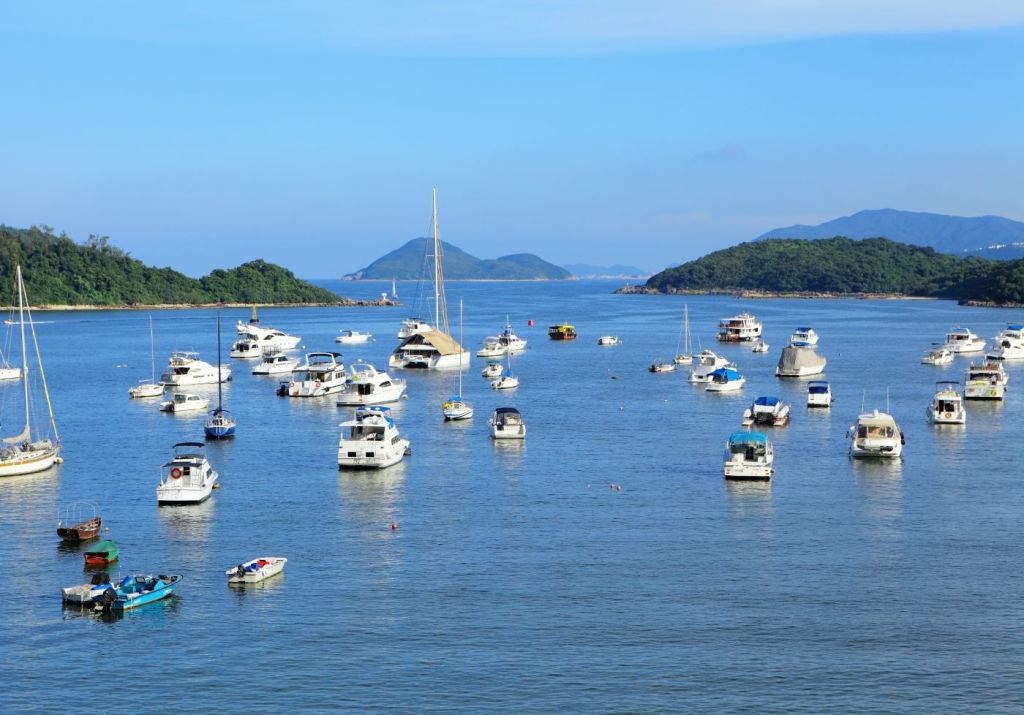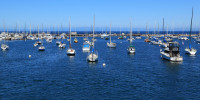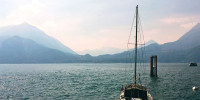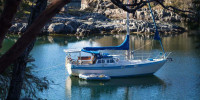How Do You Anchor in a Busy Anchorage?
Once you start anchoring everywhere, it's bound to happen - you show up to drop the hook and you see the anchorage is packed. So many boats, and so little room. So how can you set the anchor and get a good night's sleep in these conditions? The best way is to beat the crowds, but if you can't you'll need a little extra effort to anchor well.
In crowded anchorage, look for an open spot, usually near the outside of the anchorage, and anchor with a little less scope than usual to avoid swinging into other boats. Pick your drop point with care. Talk to other skippers and find out how much scope they have out, and set with the same.

The Best Tool: Planning
Block Island, Rhode Island, is a fun place to spend the Fourth of July holiday. But it's one of the busiest weekends of the year, and the easiest way to avoid the stress of anchoring in a crowd is to go somewhere less popular.
But it's popular for a reason - it's a nice place to be for families and friends. So if braving the crowds is your plan, then advance planning can save you a lot of trouble.
The fix is easy - show up early. Everyone is aiming to be there as soon as they can, but if you can take an extra day off work, you can beat most of the crowd and skip the aggravation. People coming in at dusk on July 3rd to find a spot are NOT having a good time, but they ones who showed up on the 2nd had their pick of spaces.
You may not be able to take the time off to get out early, but if you can, the best way to deal with a bad situation is avoid it completely.
And if you're expecting a crowd in the anchorage, anchor with a little less scope. Because eventually you’ll need to take up some as more and more boats drop anchor with a short scope near you.
Talk to Your New Neighbors
In a tight anchorage, odds are no one has 7:1 scope out on their anchors, and the best way to find out is just to ask. There is nothing wrong with talking to people on other boats and asking how they are anchored. And if the anchorage is crowded, the odds are good there will be someone on deck to talk to as everyone watches the newcomers and gets ready to fend off.
There are two questions you want an answer to:
- How much water are you anchored in?
- How much scope do you have out?
You can see for yourself if they have a chain or rope rode, but you cannot put out any more scope than your neighboring boats.
Aim for the Outside
It always feels that, no matter where we anchor, we're the farthest boat out. Maybe it's an overabundance of caution, but if the bottom is good for it, working the outside of the anchorage is a good way to find a spot where you can still feel safe and comfortable.
Sometimes the outside isn't such a great spot. It's usually deeper than closer to shore, and more exposed to wind and waves. But there's a lot to be said for swing room and being able to let out a little more scope.
Check the depths and make sure there's no obvious reasons no one anchors out there, like a steep drop off that would make anchoring dangerous. But even if you're dropping in ten or fifteen more feet of water than the inside boats, you can get more room on the outside.
Shorten Your Scope
Shortening scope isn't our preferred way to deal with crowds, but it's often forced on you. In crowded anchorages, it's best if everyone anchors with similar scope, so you swing together. And letting out more scope than anyone else can get you into trouble if the wind shifts.
So you may have short scope forced on you by the boats you're anchoring near, which is why it's good to talk to other skippers to make sure you're swinging like everyone else. With all-chain, we've anchored for the night with a 3:1 scope, and we've spent the night on 4:1 with a rope rode. We didn't love it, but we were fine.
It's critical that you watch the weather if you're shortening scope. If a big wind shift or increase comes in, you may drag. Along with twenty of your new neighbors. So watch the weather, and have a backup plan of somewhere else you can go if a short scope looks untenable for the incoming weather.
Anchoring in Close
Coming into a packed anchorage, you're going to have to get up close and personal with other boats. It can't be avoided if you must anchor there. Finding out as much as you can about your neighbors and how much scope they have will help ease this process and inspire a little more confidence as they stand on deck, hands on hips and glaring, watching you anchor.
Drop Your Anchor Carefully
To line up for an in-close anchor drop, draw an invisible line between the sterns of two boats you plan to anchor near. Your drop target is the midpoint of this line, or slightly over it. When you set and drop back, you'll settle back from them with plenty of swinging space around all of you.
When you're anchoring close, take it slowly - you want to be precise in your anchor placement because there's not much room for error, especially if you're anchoring directly upwind of another boat.
Mind the Swing
Although boats swing similarly in an anchorage, they don't always swing exactly the same way. A thirty-five foot keelboat, a catamaran, and a power cruiser will all be affected by the wind and currents differently.
So if you have a choice of tight anchoring spots, anchor near the boat the most like your own. Your goal is to move the same way as your neighbors, so matching boat profiles and the amount of scope you let out will give you the best chances.
Did you find the answer to your specific question?
👍 3 👎 0




Leave a comment